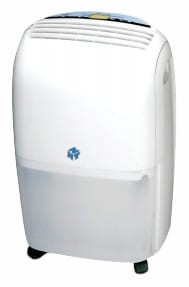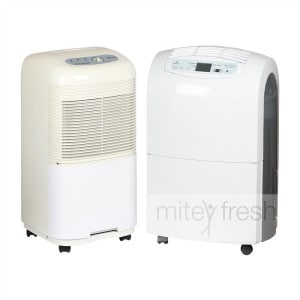Water enters buildings both as a liquid and as a gas known as water vapour. Some of the water evaporates and joins the water vapour that is exhaled by building occupants. Water vapour may move into the building through gaps, cracks and openings in the building envelope, the mechanical ventilation system or directly through the building materials themselves.
Mould growth does not require the presence of standing water, leaks, or floods. Mould can grow when the relative humidity (RH) of the air is high such as found in un-vented bathrooms, kitchen and laundry, sub floor cavities, wet foundations, air conditioning ducts, leaky roof spaces and damp basements.
What is Humidity?
Warmer air can contain more moisture than cooler air can. Absolute humidity is the mass of water vapour divided by the mass of dry air in a volume of air at a given temperature. On hot days, this additional moisture (humidity) can make people uncomfortable and feel warmer than they actually are.
Relative humidity is the ratio of the current absolute humidity to the highest possible absolute humidity depending on the current air temperature. A reading of 100 percent relative humidity (100% RH) means that the air is totally saturated with water vapour and cannot hold any more. This potentially creates the possibility of rain, though doesn’t mean that the RH must be 100% for it to rain – it must be 100% where the clouds are forming, but the relative humidity near the ground could be much less.
At 100% RH, the process of sweating is your body’s attempt to keep cool and maintain its current temperature. Your sweat will not evaporate into the air and as a result, you’ll feel much hotter than the actual air temperature
PRODUCT:
Hire a Dehumidifier
Round the clock protection when you need it most! Reduce mould, mildew, dampness, condensation, odours. Relieve hayfever, sinus headache, influenza, sneezing, itchy eyes, stuffy nose, coughing, allergic rhinitis, asthma symptoms any time of year!

Reducing the amount of moisture in the air makes moisture on the skin evaporate more readily, making you feel cooler, even though the air temperature stays the same. Less humid air 50% to 55% is much more comfortable than 70% or 80% to the skin. Many people mention that it is much easier to breathe in 50% relative humidity compared to 70% RH.
What is a Dehumidifier?
If you live in a humid climate, such as the Eastern seaboard of Australia, a dehumidifier may make a big difference for you. Excess moisture and humid air can aggravate conditions such as asthma, arthritis and rheumatism and it also contributes to mould and mildew growth.
Lowering the moisture level of the air helps prevent problems in the building. By removing moisture from the air, dehumidifiers protect areas from the damages of excess humidity. Most home owners with basements below ground know how important a dehumidifier is in keeping the basement dry to prevent mould and mildew but there are many reasons why keeping indoor air less humid is beneficial.
A dehumidifier removes moisture from the air, making homes more comfortable, and used when a room or area has been flooded by water and needs drying out. A dehumidifier can prevent mould and mildew growth.
A dehumidifier is just the opposite of a humidifier. Where humidifiers ADD moisture to the air, dehumidifiers simply REMOVE moisture, the humidity from the air.
Dehumidifiers can effectively help to prevent the mould, fungi and mildewing of stored valuables, prevent the rusting of tools, prevent swelling of floors, panel walls, drawers and doors, prevent furniture from going mouldy and much more.
PRODUCT:
Buy a Dehumidifier
Round the clock protection when you need it most! Reduce mould, mildew, dampness, condensation, odours. Relieve hayfever, sinus headache, influenza, sneezing, itchy eyes, stuffy nose, coughing, allergic rhinitis, asthma symptoms any time of year!

Dust mites and other allergens like warm, humid environments. Keeping the humidity low can be very helpful to allergy suffers. Mould tends to be wherever it is humid, basements, kitchens and bathrooms. So, removing moisture from the air in homes makes it less humid which helps in preventing mould, mildew and fungus growth as well as decreases dust mite populations indoors, creating a much more comfortable environment to live in.
It has been recognised that RH is a key factor in dust mite population growth and allergen production according to The Journal of Allergy and Clinical Immunology (1995). A controlled study determine whether the levels of mite allergen collected from mattresses decreased after dehumidifier use. The results showed a significant decrease, greater than 50% in dust mite levels in mattresses from bedrooms in which dehumidifiers were used.
Dehumidifier use is a simple and effective measure to control house dust mites, particularly suitable in humid climates, exerting an overall effect inside the bedroom and is a non-contaminating environmental control measure.
WHO (2009) cites laboratory studies have shown that dust mites require a relative humidity in excess of 45–50% for survival and development, but they feed and multiply more rapidly at higher relative humidity (Arlian, 1992). Indoor humidity is therefore the main influence on the presence and propagation of house dust mites, as confirmed in several field studies (van Strien et al., 1994; de Andrade et al., 1995; Simpson et al., 2002; van Strien et al., 2004; Zock et al., 2006). Damp houses therefore significantly increase exposure to dust-mite allergens, at least in populations living in mild and temperate climates.
Towards healthier living, Carol Parr ♥
As Building Biologists, we have acquired knowledge of adverse health effects and recommend effective strategies to reduce occupants’ exposure by eliminating and controlling as many sources of pollutants in order to create healthy indoor living environments that are as exposure-free and natural as practically possible.
References
The Journal of Allergy and Clinical Immunology (1995). “Reduction of house dust mite allergens after dehumidifier use” (Online). Available: http://www.jacionline.org/article/S0091-6749(95)70328-4/fulltext. [24 May 2015].
World Health Organisation. (2009). WHO Guidelines for Indoor Air Quality, Dampness and Mould. (Online). Available: http://www.euro.who.int/__data/assets/pdf_file/0017/43325/E92645.pdf
[6 August, 2015]
Author
-
We’re glad you’re here. We’re Carol and Tony, founders of one of the longest running Healthy Home Blogs in the world, Mitey Fresh Australia. We’ve been on this journey for the last 25 years and are passionate about helping families sift through health hazards and triggers like allergens, mould, water damage, chemicals and EMFs, to get clarity about what’s toxic and what’s not so they can create a healthy and happy home for their family they love. Each month, people visit this blog seeking focus on the health and wellbeing of their loved ones, sustainable and effective practice tips and guides, to help create and manage healthier indoor spaces, improve the built environment that is pleasing to the senses and support healthy living and nature, every day. Starting this blog was to help change people’s lives, one family at a time, and we can’t wait to share how its allowed us to stand next to you and show you how interpreting these synergies between buildings and the environment they are built in will impact upon the health and well-being of those who occupy them. Find out more about Healthy Homes and what this blog can do for you!





